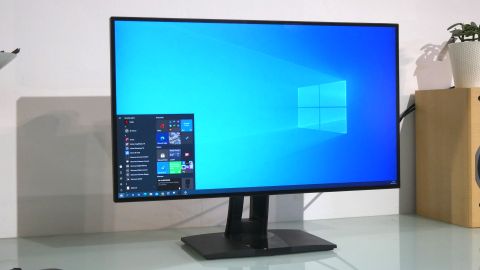TechRadar Verdict
Viewsonic’s latest 27-inch monitor is a remarkably affordable 1440p SDR content creation panel with added USB-C goodness
Pros
- +
Pantone validation and factory calibration
- +
USB-C with charging and ethernet
- +
Great all-round feature set
Cons
- -
Limited support for more demanding gamuts
- -
No HDR support
Why you can trust TechRadar
Full 4K resolution has become somewhat synonymous with serious content creation workflows. But if you’re not actually working with UHD content, there’s an argument for opting for a lower resolution QHD or 1440p panel and maximizing your spending power on other areas of image quality and features.
Overall: 4
Design: 4
Features: 4.5
Performance: 4
Usability: 4
Value: 4.5
That’s essentially the philosophy behind the new Viewsonic VP2768a. It’s a 27-inch model with a 2,560 by 1,440 pixel IPS panel. It majors on SDR rather than HDR color accuracy with features like Pantone validation and extensive calibration options. It also packs full USB-C functionality including single-cable video input and charging, plus ethernet forwarding.
Critically, it does all that for a price that’s far more affordable than an alternative 4K monitor that matches it in every other regard. It’s also far cheaper than an similarly capable 1440p panel would have been just a few years ago.
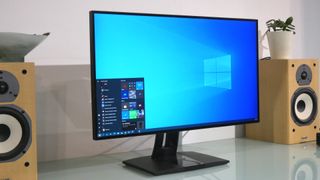
Price and availability
At $411 in the US and £363 in the UK, the Viewsonic VP2768a looks like conspicuous value given its combination of features including Pantone validation and single-cable USB-C connectivity.
So long as support for 4K workflows isn’t required, the Viewsonic VP2768a is an awfully appealing cut-price content creation option, albeit with some limitations regarding color coverage. Just note that prices currently vary significantly among retailers, so it pays to shop carefully.
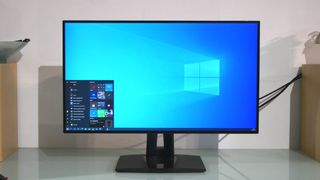
Design and features
With slim and symmetrical bezels on all four sides of its 27-inch IPS panel, the Viewsonic VP2768a looks compact and clean. The all-plastic stand is arguably a little dated and certainly short on visual delights.
But with a full range of adjustability, including rotation into portrait orientation, the functionality is certainly there.
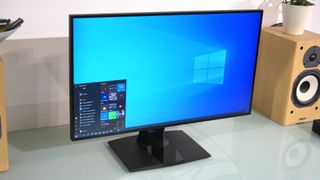
Indeed, that notion of functionality is something that applies pretty broadly to this punchily priced productivity panel. At 27 inches with a 2,560 by 1,440 pixel or 1440p native resolution, there’s reasonable desktop space to work with.
Panel size 27-inch
Panel type IPS
Resolution 2,560 x 1,440
Brightness 350cd/m2
Contrast 1000:1
Pixel response 5ms
Color coverage 83% AdobeRGB, 112% sRGB
Refresh rate 60Hz
Vesa 100mm x 100mm
Inputs DisplayPort 1.2 in and out, HDMI 1.4 x2, USB-C, ethernet
More impressive, for the most part, is the detailed specification when it comes to color accuracy. That starts with Pantone Validation and extends to six-axis color adjustment and a 14-bit LUT.
Hardware calibration is also available with the optional ViewSonic Calibration Kit and third-party hardware calibration including X-Rite and Datacolor is supported, too.
One area of relative weakness, however, concerns color coverage. The sRGB and Rec. 709 are fully 100 percent covered. But DCI P3 is quoted at 83 percent coverage while support for the Adobe RGB gamut is limited to 78 percent. That’s certainly less than you’d want if regularly working in those spaces. Also note that this is not an HDR panel even in terms of supporting an HDR signal input.

Elsewhere, it’s mostly good news thanks to a strong all-round feature set. Connectivity includes USB-C with both 90W of charging support and ethernet passthrough. There’s also display daisy-chaining via both the USB-C and the DisplayPort inputs, plus a pair of HDMI ports. Rounding things out is what Viewsonic claims is the world’s first TUV-tested color blindness mode and a generous three-year warranty,
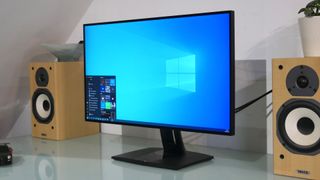
Performance
Viewsonic factory calibrates each VP2768a with the aim of delivering Delta Es below two for the sRGB, EBU, SMPTE-C, Rec. 709, and DICOM-SIM color spaces. The included calibration report shows average Delta E of 1.17 in sRGB and 1.19 in Rec. 709, with only a few deviations slightly above 2 in either space, indicating essentially no errors visible to the human eye.
Luminance variation in the report is also very, very tight with just 0.4% deviation between the brightest and darkest patches of the screen. The OSD menu supports three different calibration memory slots, so multiple calibrated work spaces can be stored in parallel.

Speaking of the OSD, it’s very comprehensive thanks to six-axis color adjustment and also has features familiar from Viewsonic’s more mainstream displays, such as a low input lag mode and user-configurable overdrive for improved pixel response.
The only obvious shortcoming is the limitation to sRGB, Rec. 709 and DICOM SIM gamut presets. The likes of Adobe RGB and DCI-P3 are conspicuous absentees.
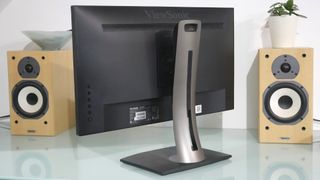
As for the subjective image quality, this is an SDR panel rated at 350 nits. So, it’s not going to blow your eyeballs out. But it is decently vibrant and in sRGB mode it looks very natural and precise, with good contrast for an IPS panel and excellent viewing angles.
Of course, as a 27-inch 1440p panel, the pixel pitch of 109DPI is a long way off the 163DPI of a 27-inch 4K monitor. So, it’s not as sharp or detailed and fonts are noticeably less crisp and pleasing. But then you’ll pay handsomely for a Pantone Validated 4K monitor with USB-C connectivity.

Verdict
As a cut-price 1440p content creation panel with Pantone Validation for working in the sRGB or Rec. 709 gamuts, the Viewsonic VP2768a has a lot going for it. That’s especially true thanks to features like USB-C connectivity with charging and ethernet support.
Limited color coverage in more demanding color spaces like Adobe RGB does limit its appeal as an all-round content creation tool, as does the lack of HDR support. But if your primary workflows are sRGB or similar, then the Viewsonic VP2768a’s aggressive pricing and broader feature set are awfully appealing.
- We've featured the best business monitors.
Technology and cars. Increasingly the twain shall meet. Which is handy, because Jeremy (Twitter) is addicted to both. Long-time tech journalist, former editor of iCar magazine and incumbent car guru for T3 magazine, Jeremy reckons in-car technology is about to go thermonuclear. No, not exploding cars. That would be silly. And dangerous. But rather an explosive period of unprecedented innovation. Enjoy the ride.
